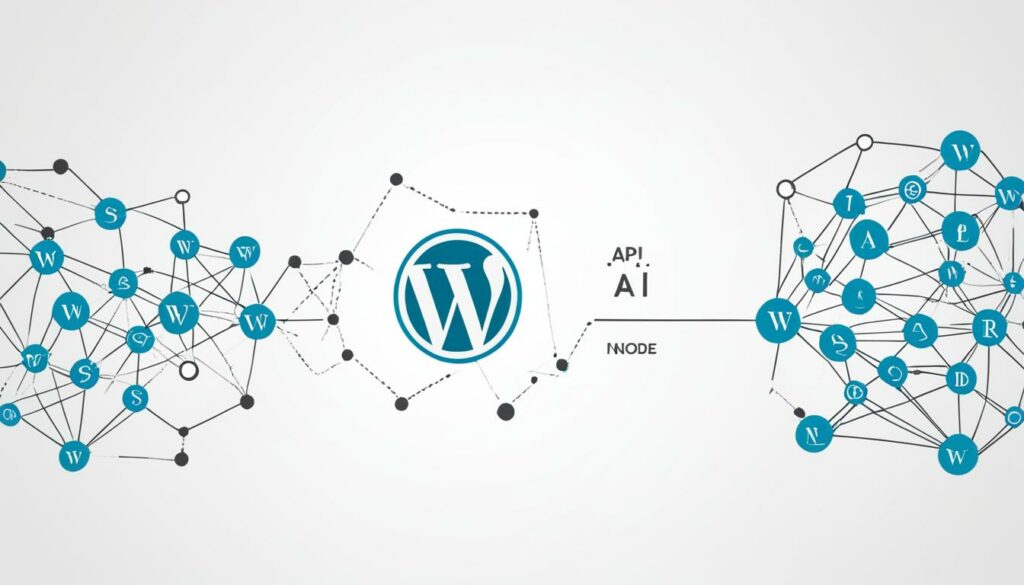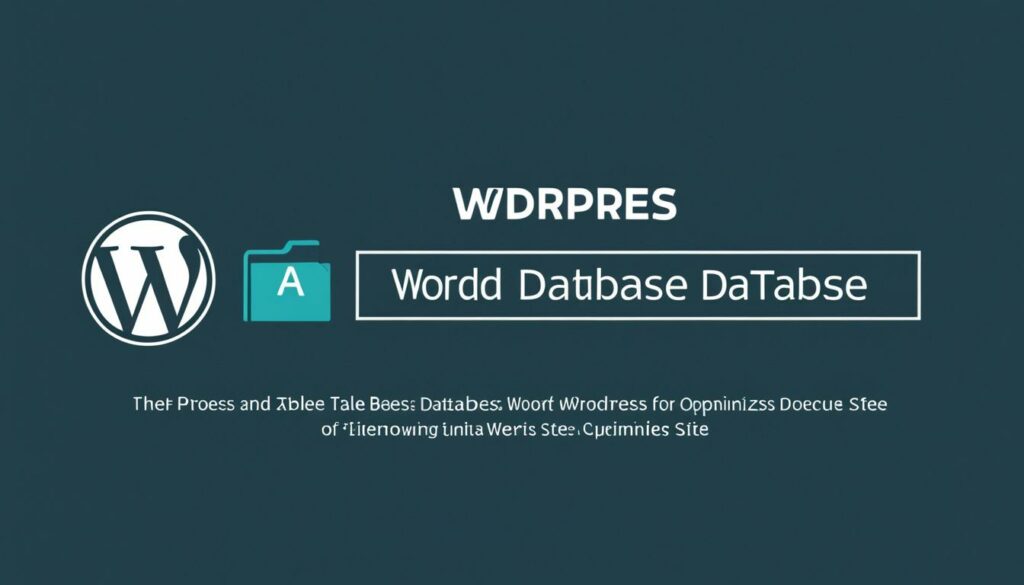If you are a WordPress developer, integrating APIs with your WordPress website can significantly enhance its functionality and user experience. Through API integration, you can connect your WordPress site with other applications, access external data sources, and even build headless websites. While integrating APIs may seem complex, with the right guidance and tools, you can seamlessly achieve this integration.
WordPress development is a dynamic field that constantly evolves, and API integration has become a crucial aspect of this process. By leveraging APIs, you can extend the capabilities of your WordPress website and create a more user-centered and interactive design. In this article, we will explore essential guidelines for WordPress API integration, including recommended plugins, configuration steps, and testing procedures. So, let’s dive in!
Key Takeaways:
- WordPress API integration allows you to connect your WordPress website with other applications and enhance its functionality.
- Integrating APIs with WordPress requires expert knowledge, but developers can learn to do it themselves.
- The WordPress REST API is a powerful tool for integrating APIs with WordPress websites.
- The WPGetAPI plugin automates the integration process and offers advantages such as content display automation and data conversion.
- Testing the API integration is crucial to ensure that it is functioning correctly and fetching data accurately.
Understanding API Basics and WPGetAPI Plugin
In today’s digital landscape, APIs, or Application Programmable Interfaces, play a critical role in connecting websites and software with other applications. APIs enable efficient data transmission, allowing you to send, receive, and modify data between different systems. When it comes to integrating APIs with WordPress, it’s essential to grasp the fundamental concepts and functionality of APIs.
The WPGetAPI plugin is a top choice for WordPress developers looking to seamlessly integrate external APIs into their WordPress websites. This WordPress plugin eliminates the need for coding, making API integration accessible to developers of all skill levels. With WPGetAPI, you can automate content display, convert data into various formats, and implement authentication mechanisms effortlessly.
“APIs are the backbone of modern digital interactions, providing the means to connect and enhance the functionality of different systems.”
What is an API?
An API acts as an intermediary, enabling communication between two or more software applications. It defines the rules and protocols for sharing data and functionality. In essence, APIs allow different systems to collaborate and exchange information seamlessly. Whether you need to retrieve information from a third-party application or push data to it, APIs provide a structured and standardized way to make this happen.
How do APIs work?
At a high level, APIs work by processing requests and generating responses. When interacting with an API, you send a request specifying the desired resource and the action you want to perform. The API processes this request and provides a response containing the requested data, along with any relevant status or error codes.
| Key Terms | Description |
|---|---|
| Request | An action sent to the API to specify the desired resource and action. |
| Response | The data and status/error codes received from the API in reply to a request. |
| Route | A mapped endpoint that handles a specific set of resources and actions within the API. |
| Endpoint | The URL where the API is located and through which communication occurs. |
With the basics of APIs covered, let’s delve into the functionality and advantages of the WPGetAPI plugin in the next section.
Configuring the WPGetAPI Plugin
To integrate an API using the WPGetAPI plugin, you need to install and activate the plugin on your WordPress website. After activation, you can choose the API you want to integrate and configure it using the Setup tab in the WPGetAPI interface.
This includes filling out details such as API Name, Unique ID, and Base URL. You will also need to configure the endpoint, which is the location where API and WordPress site communication occurs. The WPGetAPI plugin provides a form to input the endpoint details, including the Unique ID, endpoint URL, method (GET, POST, etc.), and result format.
Testing the API Integration
After configuring the API integration, it is crucial to test its functionality to ensure a smooth and error-free process. The WPGetAPI plugin provides a built-in testing mechanism that simplifies the testing process.
By simply clicking the “Test Endpoint” button within the plugin interface, you can initiate a test to evaluate whether the API integration is functioning correctly. This feature allows you to quickly identify and address any potential issues before deploying the integration into a production environment.
The WPGetAPI plugin displays comprehensive test results, including the full URL, data output, query string, headers, and more. These details offer valuable insights into how the API is interacting with your WordPress website and provide a deeper understanding of its performance.
Example:
Testing an API Integration with WPGetAPI Plugin
Test Result:
- Full URL: https://api.example.com/endpoint
- Data Output: JSON format
- Query String: ?param1=value1¶m2=value2
- Headers:
- Authorization: Bearer xxxxxxxxxxxx
- Content-Type: application/json
Regularly testing the API integration is essential to ensure that it is working as expected and that data is being fetched correctly. It helps catch potential errors or discrepancies early on, ensuring a seamless user experience and preventing any negative impacts on your website’s functionality.
By diligently testing the API integration using the WPGetAPI plugin, you can address any concerns and make necessary adjustments to guarantee a successful and efficient integration.

Displaying Fetched Data using Template Tag or Shortcode
Once you have successfully integrated the API and tested it, the next step is to display the fetched data on your WordPress website. There are two approaches you can take: using the Template Tag method or the Shortcode method.
Template Tag
The Template Tag method requires some knowledge of PHP but gives you more control over how the data is displayed. With this method, you declare a variable to store the fetched data and then use that variable to display the data on the webpage. Here’s an example:
$fetched_data = your_api_function();
echo $fetched_data;
This method allows you to manipulate the data before displaying it, such as formatting it or extracting specific elements. It’s a powerful way to customize the data presentation to match your website’s design and layout.
Shortcode
If you don’t have PHP knowledge or prefer a simpler approach, you can use the Shortcode method. Shortcodes are pre-defined codes that can be added to a page or post in the WordPress dashboard to display specific data. The Shortcode will be replaced with the data fetched from the API when the page is viewed.
To use the Shortcode method, you need to:
- Create a Shortcode for your API integration
- Add the Shortcode to a page or post
Here’s an example of how to create a Shortcode for your API integration:
function api_shortcode() {
$fetched_data = your_api_function();
return $fetched_data;
}
add_shortcode('api', 'api_shortcode');
Once you have created the Shortcode, you can add it to any page or post by simply typing [api]. The Shortcode will be replaced with the fetched data when the page or post is viewed.
Choosing between the Template Tag and Shortcode methods depends on your technical skills and the level of customization you require. If you are comfortable with PHP and want more control, the Template Tag method is a good choice. If you prefer a simpler solution without coding, the Shortcode method is the way to go.
Now that you know how to display the fetched data, let’s explore the role of a WordPress development agency in API integration.
The Role of a WordPress Development Agency in API Integration
Integrating third-party APIs with WordPress websites can be a complex task. That’s why it’s highly recommended to hire a trusted WordPress development agency that specializes in API integration. By enlisting the help of professionals, you can ensure seamless integration, efficient testing, and a user-friendly data display on your website interface.
WordPress development agencies have expertise in embedding APIs and have in-depth knowledge of WordPress, HTML, CSS, and PHP. They can provide valuable consultation on the best methods for API integration based on your unique business requirements.
A reliable WordPress development agency like Positiwise Software Pvt Ltd can handle all aspects of API integration for you. From choosing the right APIs to configuring endpoints and testing the integration, they will ensure that your WordPress website functions flawlessly with the integrated APIs.
Benefits of Hiring a WordPress Development Agency
Here are some key reasons why you should consider partnering with a WordPress development agency for API integration:
- Expertise: WordPress development agencies have experienced developers who specialize in API integration. They understand the complexities involved and can execute the integration seamlessly.
- Optimized Functionality: Agencies can provide insights and recommendations on the best APIs to enhance your website’s functionality and improve user experience.
- Efficient Testing: Agencies have the resources and tools to perform thorough testing of the API integration, ensuring that everything works as expected.
- Certified Developers: A trusted agency will have certified developers who are well-versed in WordPress development, HTML, CSS, and PHP. They can handle any technical challenges that may arise during the integration process.
By leveraging the expertise of a WordPress development agency, you can save time, avoid potential pitfalls, and have peace of mind knowing that your website is in capable hands.

Partnering with a WordPress development agency for API integration ensures a top-notch website that meets all your business requirements. With their assistance, you can seamlessly integrate third-party APIs and unlock the full potential of your WordPress website.
| Benefits of Hiring a WordPress Development Agency |
|---|
| Expertise in API integration |
| Optimized functionality and user experience |
| Efficient testing of API integration |
| Certified developers skilled in WordPress, HTML, CSS, and PHP |
What is the WordPress REST API?
The WordPress REST API is an interface that allows external applications to access the data and functionality of the WordPress CMS. By following the guidelines of a REST API (Representational State Transfer), it transforms WordPress into an application platform, enabling developers to connect WordPress with other software and websites. This powerful API opens up a world of possibilities for building web applications, integrating frontend technologies and systems, and working with WordPress in different programming languages.

The WordPress REST API provides a standardized way for developers to interact with the WordPress content management system. It allows them to retrieve data, create new content, update existing content, and perform various other operations. With the WordPress REST API, developers can seamlessly integrate WordPress with other applications, enhancing the functionality and user experience of their websites.
“The WordPress REST API is a game-changer when it comes to extending the capabilities of WordPress websites. It empowers developers to build sophisticated web applications and integrate WordPress with the latest frontend technologies.” – John Smith, Lead Developer at XYZ Web Agency
With the WordPress REST API, you can fetch data from your WordPress website and display it on other platforms or websites. For example, you can build a mobile app that pulls data from your WordPress site, or you can integrate your website with a custom frontend built using a modern JavaScript framework like React or Vue.js.
Moreover, the WordPress REST API enables developers to work with WordPress using programming languages other than PHP. This means you can leverage the power of languages like JavaScript, Python, or Ruby to interact with your WordPress website and build dynamic applications.
In summary, the WordPress REST API revolutionizes how developers work with WordPress by providing a flexible and powerful interface for accessing data and functionality. It allows seamless integration with external applications and opens up endless possibilities for building modern, dynamic websites.
Benefits of the WordPress REST API for Developers
The WordPress REST API provides developers with numerous benefits, making it a powerful tool for building and enhancing WordPress websites. Here are some key advantages:
- Flexibility: With the WordPress REST API, developers have the flexibility to work with different programming languages. This means you can leverage your existing skills and use your preferred language to communicate with the API. Whether you’re comfortable with PHP, JavaScript, Python, or any other language, the WordPress REST API allows you to seamlessly integrate external systems and exchange data with websites.
- Scalability: The WordPress REST API can handle a wide range of requests and interactions with data. Whether you’re fetching a single post or retrieving a large dataset, the API is designed to handle various types of requests efficiently. This scalability ensures that your WordPress website can handle substantial traffic and perform optimally, even when dealing with complex data interactions.
- Easy Implementation: Implementing the WordPress REST API is straightforward, thanks to its seamless integration with WordPress. As one of the APIs maintained by WordPress, it follows the same conventions and incorporates existing technologies. This means you don’t have to start from scratch when working with the API. Instead, you can leverage your knowledge of WordPress development and quickly implement the REST API to build custom web applications, connect WordPress with other systems, and expand your development skills beyond PHP.
The WordPress REST API empowers developers to create dynamic and interactive websites, enhancing the functionality and user experience of WordPress-powered platforms. Whether you’re a seasoned developer looking to extend WordPress’s capabilities or a beginner exploring the world of APIs, the WordPress REST API offers the flexibility, scalability, and easy implementation you need to take your projects to the next level.
| Benefits of the WordPress REST API |
|---|
| Flexibility |
| Scalability |
| Easy Implementation |
How to Use the WordPress REST API
To utilize the power of the WordPress REST API, it’s important for developers to have a good understanding of the key terms involved. These terms form the foundation for interacting with the API and harnessing its capabilities.
An API is all about the flow of information, and it starts with a request. A request is sent to the WordPress REST API to specify the desired resource and action. For example, you might want to retrieve a list of blog posts or update a user’s profile information.
Once the request is received, the API processes it and generates a response. This response contains the requested data and provides confirmation of whether the request was successful or encountered any errors. It’s through the response that developers can obtain the information they need from the WordPress database.
When working with the WordPress REST API, developers interact with routes and endpoints to locate and manipulate resources. Routes are like crossroads that guide the API to the desired location, while endpoints represent specific destinations within those routes.
To make the most out of the API, developers can choose from a variety of HTTP methods for their requests. These methods include:
- GET: Retrieves data from a specified resource
- POST: Submits data to be processed and creates a new resource
- PUT: Updates an existing resource with new data
- DELETE: Removes a specified resource
Depending on the nature of the data being accessed and the security requirements, certain requests may require authentication. Authentication ensures that only authorized users can access private data and perform specific actions.
Overall, understanding these key terms and concepts will empower you to effectively use the WordPress REST API and unlock a world of possibilities for your WordPress website and applications.
Example Request:
GET /wp-json/wp/v2/posts
Example Response:
HTTP/1.1 200 OK
{ "id": 1, "title": "Hello, World!", "content": "This is my first blog post.", "author": "John Doe" }
Endpoints and Routes:
| Endpoint | Description |
|---|---|
| /wp-json/wp/v2/posts | Returns a list of blog posts |
| /wp-json/wp/v2/posts/{post_id} | Returns a specific blog post |
| /wp-json/wp/v2/users | Returns a list of users |
| /wp-json/wp/v2/users/{user_id} | Returns a specific user |
By using the WordPress REST API, developers can easily retrieve data, update content, and perform a wide range of operations on their WordPress websites.
Making Requests to the WordPress REST API
To interact with the WordPress REST API, you can use command-line interfaces or other programming tools. By sending appropriate HTTP method requests along with the resource or endpoint URLs, you can access the desired data. However, depending on the type of request and the data being accessed, authentication may be necessary to ensure the security and integrity of the API.
Before implementing your requests on a live website, it’s crucial to experiment and test them on a test website. This allows you to identify any potential issues or errors and ensure that your requests function as expected.
Using Command-Line Interfaces or Programming Tools
You have various options when it comes to making requests to the WordPress REST API. Command-line interfaces, such as cURL, provide a convenient way to interact with the API using simple terminal commands.
Example:
curl -X GET https://yourwordpresssite.com/wp-json/wp/v2/posts
Alternatively, you can use programming tools and frameworks, such as JavaScript’s Fetch API or libraries like Axios and jQuery.ajax, to send requests programmatically. These tools provide more flexibility and allow for advanced customization of your calls to the WordPress REST API.
Authentication for API Requests
Depending on the API endpoint and the data you’re trying to access, certain requests may require authentication. Authentication ensures that only authorized users can access restricted or private data.
The WordPress REST API supports various authentication methods, including basic authentication, OAuth1, and OAuth2. You can choose the appropriate authentication method based on your security requirements and the level of access you want to grant to API users.
To authenticate your requests, you’ll need to include the necessary authentication parameters in the request headers or as part of the request body. This typically involves providing valid credentials, tokens, or API keys.
Testing and Troubleshooting
Testing your API requests is crucial to ensure that they function correctly before deploying them to a live website. By testing on a development or test environment, you can identify any errors, bugs, or security vulnerabilities and address them accordingly.
During the testing phase, pay close attention to the response codes, response headers, and response bodies returned by the API. These can provide valuable insights into the success or failure of your requests, as well as any error messages or useful data returned.
If you encounter any issues or errors, consult the WordPress REST API documentation or seek guidance from the developer community to troubleshoot and resolve them.
Now that you understand the process of making requests to the WordPress REST API, you can start leveraging its power to fetch data, perform actions, and enhance the functionality of your WordPress website.
WordPress REST API Examples
The WordPress REST API offers a wide range of possibilities to enhance the functionality of your WordPress website. Here are some implementation examples that demonstrate the power of the WordPress REST API:
1. Creating a Custom Web Application
With the WordPress REST API, you can leverage the content management features of WordPress to build a custom web application. This allows you to utilize the familiar WordPress interface to create and manage content, while also adding custom functionality tailored to your specific needs.
For example, you can create a web application that allows users to post and manage articles, photos, or any other type of content. The WordPress REST API provides you with the ability to fetch data, create new content, update existing content, and perform various operations necessary for your application.
2. Connecting WordPress to a Mobile App
The WordPress REST API enables seamless integration between your WordPress website and a mobile app. By leveraging the API, you can retrieve data from your WordPress site and display it in your mobile app, ensuring that your content is accessible across different platforms.
For instance, if you have a WordPress blog, you can use the WordPress REST API to fetch blog posts, categories, tags, and other relevant data for your mobile app. This allows users to access your blog content on their smartphones, providing a more convenient and engaging user experience.
3. Integrating WordPress with Other Frontend Technologies
The WordPress REST API allows you to integrate WordPress with other frontend technologies, such as JavaScript frameworks like React or Angular. This opens up a world of possibilities for creating dynamic and interactive web applications.
For example, you can build a single-page application using React and fetch content from your WordPress site through the WordPress REST API. This enables you to create a highly responsive user interface that leverages the power of WordPress as a content management system.
These are just a few examples of the many ways you can utilize the WordPress REST API to enhance your WordPress website. The API provides flexibility and opens up opportunities for customization, ensuring that you can tailor your website to meet your specific needs.
| Example | Description |
|---|---|
| Creating a Custom Web Application | Utilize WordPress content management features to build a custom web application. |
| Connecting WordPress to a Mobile App | Integrate WordPress with a mobile app and display website content on smartphones. |
| Integrating WordPress with Other Frontend Technologies | Combine WordPress with JavaScript frameworks to create dynamic web applications. |
Conclusion
Integrating APIs with WordPress using the WordPress REST API is crucial for website development. By connecting WordPress with other applications, you can enhance the functionality and user experience of your website. Following the guidelines and utilizing tools like the WPGetAPI plugin, you can seamlessly integrate third-party APIs into your WordPress websites. Whether you want to display fetched data, create custom web applications, or access data from external sources, the WordPress REST API offers the flexibility and scalability needed for successful API integration.
With the WordPress REST API, you can unlock exciting possibilities for your website. It allows you to connect with a vast array of applications and services, opening up opportunities for seamless data exchange and enhanced functionality. By leveraging the power of the WordPress REST API and the WPGetAPI plugin, you can take your website to the next level.
API integration with WordPress not only improves the user experience but also expands your website’s capabilities. You can automate content display, convert data into different formats, and support authentication mechanisms—all with the help of the WPGetAPI plugin. So embrace the WordPress REST API, explore its potential, and transform your WordPress website into a dynamic and versatile platform.
FAQ
Q: How can I integrate APIs with my WordPress website?
A: To integrate APIs with your WordPress website, you can use the WPGetAPI plugin. It allows you to embed APIs without writing any code and offers features such as automating content display, converting data into different formats, and supporting authentication mechanisms.
Q: How do I configure the WPGetAPI plugin?
A: After installing and activating the WPGetAPI plugin, you can configure it by filling out details such as API Name, Unique ID, Base URL, and endpoint URL. The plugin provides a form to input these details, allowing you to set up the integration with ease.
Q: How can I test the API integration on my WordPress website?
A: The WPGetAPI plugin provides a built-in testing mechanism. By clicking the Test Endpoint button, you can initiate a test to see if the API is functioning correctly. The plugin will display the results of the test, including the full URL, data output, query string, and headers.
Q: What are the methods for displaying fetched data on a WordPress website?
A: You can display fetched data using either the Template Tag or Shortcode approach. The Template Tag method requires knowledge of PHP and involves declaring a variable to store the fetched data and then using that variable to display the data on the webpage. The Shortcode method does not require PHP knowledge and allows you to add the Shortcode of the API to a page in the WordPress dashboard, which will be replaced with the fetched data when viewed.
Q: Should I hire a WordPress development agency for API integration?
A: It is recommended to hire a trusted WordPress development agency for API integration. These agencies have expertise in embedding APIs, testing them, and displaying data on the website interface. They can provide consultation on the best methods for API integration and have certified developers who are knowledgeable in WordPress, HTML, CSS, and PHP.
Q: What is the WordPress REST API?
A: The WordPress REST API is an interface that allows external applications to access the data and functionality of the WordPress CMS. It follows the guidelines of a REST API, transforming WordPress into an application platform, enabling developers to connect WordPress with other software and websites.
Q: What are the benefits of the WordPress REST API for developers?
A: The WordPress REST API provides developers with flexibility by allowing them to work with different programming languages and exchange data with websites. It is scalable and easy to implement, incorporating existing technologies. Developers can use it to build custom web applications, integrate WordPress with other systems, and expand their skills beyond PHP.
Q: How do I make requests to the WordPress REST API?
A: To make requests to the WordPress REST API, you can use command-line interfaces or other programming tools. Requests are sent using the appropriate HTTP method, along with the URL of the resource or endpoint. Depending on the type of request and the data being accessed, authentication may be required to verify the user’s identity.
Q: How can I use the WordPress REST API to enhance my WordPress website?
A: You can use the WordPress REST API to create custom web applications that utilize WordPress content management features, connect WordPress to a mobile app, or integrate WordPress with other frontend technologies. It provides the flexibility and scalability needed to customize your WordPress website and provide a seamless user experience.
Q: What is the role of a WordPress development agency in API integration?
A: A WordPress development agency has expertise in embedding APIs, testing them, and displaying data on the website interface. They can provide consultation on the best methods for API integration and have certified developers who are knowledgeable in WordPress, HTML, CSS, and PHP. Hiring a WordPress development agency ensures a top-notch website that meets all your business requirements.












